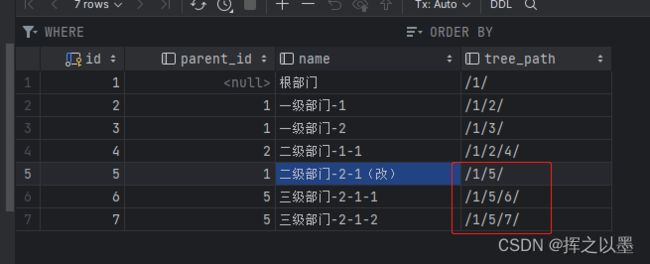【设计模式】组合模式实现部门树实践
1.前言
几乎在每一个系统的开发过程中,都会遇到一些树状结构的开发需求,例如:组织机构树,部门树,菜单树等。只要是需要开发这种树状结构的需求,我们都可以使用组合模式来完成。
本篇将结合组合模式与Mysql实现一个部门树,完成其增删改和树形结构的组装。
2.组合模式
组合模式是一种结构型设计模式,它允许我们将对象组合成树形结构来表现部分-整体的层次结构。以部门树为例,我们可以将上级部门与下级部门组合起来,形成一个单边树,用代码来描述的话,就是这个样子的:
public class DeptNode {
private List<DeptNode> children = new ArrayList<>();
}
提供一个部门节点类,里面会有一个集合,用于保存当前部门的下级部门,同理在children这个集合中的部门节点,也可能会有它的下级部门节点。
当然,这不是实现组合模式的唯一方式,还有其他复杂一点方式,会区分不同的节点类型,是根节点、分支节点、还是叶子节点等。这里之所以做这种简单的设计,是因为我们的树状结构的数据一般都会交给前端去做渲染,在很多前端的组件库中,就是用这种简单的方式来组织树的,例如在Element-UI中的树状结构:

3.实现方式
3.1.数据结构设计
先看数据库的设计,数据库必要的字段比较简单,直接看一下建表的sql:
create table dept
(
id bigint auto_increment comment '部门id'
primary key,
parent_id bigint null comment '上级部门id',
name varchar(200) null comment '部门名称',
tree_path varchar(255) null comment '树路径'
)
id与parent_id很好理解,主要是用来维护部门的上下级关系,name不解释,tree_path这个字段其实不是必须要的,没有它也可以实现部门树,但是加上这个path之后,可以比较方便的查询子树。
PO对象与数据库字段保持一致,这里就不过多赘述,代码中需要返回给前端的树对象要修改一下字段名,name->label:
@Getter
@Setter
public class DeptNode {
private List<DeptNode> children = new ArrayList<>();
private Long id;
private Long parentId;
private String label;
private String treePath;
}
3.2.数据新增
由于是自增主键,数据的新增需要再保存之后获取到主键id,再更新treePath。
这里为了方便,我用了dept对象直接透传,使用的是mybatis-plus操作数据库,可以替换成自己喜欢的ORM。
@Service("deptService")
public class DeptServiceImpl extends ServiceImpl<DeptDao, Dept> implements DeptService {
@Override
@Transactional(rollbackFor = Exception.class)
public void insert(Dept dept) {
// 如果有上级部门id,则获取上级机构
Dept parentDept = null;
if (dept.getParentId() != null) {
parentDept = this.getById(dept.getParentId());
// 上级机构不能为空
if (parentDept == null) {
throw new RuntimeException("上级机构不存在");
}
}
// MybatisPlus新增后可以获取主键
this.save(dept);
// 更新树路径
if (parentDept != null) {
dept.setTreePath(parentDept.getTreePath() + dept.getId() + "/");
} else {
dept.setTreePath("/" + dept.getId() + "/");
}
this.updateById(dept);
}
}
3.2.数据更新
数据更新需要注意两个点:
- 新的上级部门不能是自己,也不能是自己的子部门(避免成环)。
- 更新树路径之后,树路径上的所有子部门都需要更新树路径。
@Override
@Transactional(rollbackFor = Exception.class)
public void update(Dept dept) {
Dept newParentDept = null;
if (dept.getParentId() != null) {
newParentDept = this.getById(dept.getParentId());
if (newParentDept == null) {
throw new RuntimeException("上级部门不存在");
}
if (newParentDept.getTreePath().contains("/" + dept.getId() + "/")) {
throw new RuntimeException("上级部门不能是自己或子部门");
}
}
this.updateById(dept);
// 组装新的树路径
String newTreePath = (newParentDept == null ? "" : newParentDept.getTreePath()) + dept.getId() + "/"; + dept.getId() + "/";
// 获取原有的树路径
String oldTreePath = this.getById(dept.getId()).getTreePath();
// 获取所有子部门(循环更新也可以替换为使用Mysql的replace函数批量更新)
LambdaQueryWrapper<Dept> queryWrapper = new LambdaQueryWrapper<>();
// likeRight表示右模糊查询,即以oldTreePath开头的
queryWrapper.likeRight(Dept::getTreePath, oldTreePath);
this.list(queryWrapper).forEach(childDept -> {
// 更新子部门的树路径
childDept.setTreePath(childDept.getTreePath().replace(oldTreePath, newTreePath));
this.updateById(childDept);
});
}
上面的循环更新在数据量不大的时候可以这么做,如果量较大的话,推荐使用mysql中的replace函数替换:
update dept set tree_path = replace(tree_path,'旧路径','新路径')
where tree_path like '旧路径%'
把sql中的旧路径,新路径替换为上面代码中获取到的路径即可。
3.4.部门树组装
部门树组装只需要把需要组装的部门列表查询出来,然后根据parent_id的关联关系组装数据即可。这里tree_path就可以派上用场了,如果只有parent_id的话,要么必须全量查询所有的部门再过滤,要么需要根据parent_id做递归查询,而通过tree_path可以直接做右模糊查询,查询到的部门都是需要的部门。
我们可以在接口中接收一个部门的id,把这个部门作为部门子树的根节点:
@Override
public List<DeptNode> tree(Long id) {
// 传入了主键id,则通过主键id对于treePath做右模糊查询,没有传入主键id,则查询所有
List<Dept> list;
if (id != null) {
Dept baseDept = this.getById(id);
list = this.list(new LambdaQueryWrapper<Dept>().likeRight(Dept::getTreePath, baseDept.getTreePath()));
} else {
list = this.list();
}
// 将Dept转换为DeptNode
List<DeptNode> deptNodes = new ArrayList<>();
for (Dept dept : list) {
DeptNode deptNode = BeanUtil.copyProperties(dept, DeptNode.class);
deptNode.setLabel(dept.getName());
deptNodes.add(deptNode);
}
// 循环遍历,将子节点放入父节点的children中
for (DeptNode node : deptNodes) {
deptNodes.stream().filter(item -> node.getId().equals(item.getParentId())).forEach(item -> {
if (node.getChildren() == null) {
node.setChildren(CollUtil.newArrayList(item));
} else {
node.getChildren().add(item);
}
});
}
// 返回根节点
return deptNodes.stream()
.filter(item -> item.getParentId() == null || item.getId().equals(id))
.collect(Collectors.toList());
}
4.测试
通过一个Controller接口发起测试:
@RestController
@RequestMapping("dept")
public class DeptController {
@Resource
private DeptService deptService;
@PostMapping("insert")
public void insert(@RequestBody @Valid Dept dept) {
this.deptService.insert(dept);
}
@PostMapping("update")
public void update(@RequestBody @Valid Dept dept) {
this.deptService.update(dept);
}
@PostMapping("/tree")
public List<DeptNode> tree(Long id) {
return this.deptService.tree(id);
}
}
4.1.部门新增
按照下面的请求参数顺序发起insert请求,为了验证的方便,这里的部门加了数字后缀:
{
"parentId": null,
"name": "根部门"
}
{
"parentId": 1,
"name": "一级部门-1"
}
{
"parentId": 1,
"name": "一级部门-2"
}
{
"parentId": 2,
"name": "二级部门-1-1"
}
{
"parentId": 3,
"name": "二级部门-2-1"
}
{
"parentId": 5,
"name": "三级部门-2-1-1"
}
{
"parentId": 5,
"name": "三级部门-2-1-2"
}
执行后数据的结果如下,我们可以看到tree_path已经正常添加好了:

通过tree接口,不传id获取到的树结构如下,按照上面说的部门后缀进行对比验证,可以看出部门树已经正确组装了。
[
{
"children": [
{
"children": [
{
"children": [],
"id": 4,
"parentId": 2,
"label": "二级部门-1-1",
"treePath": "/1/2/4/"
}
],
"id": 2,
"parentId": 1,
"label": "一级部门-1",
"treePath": "/1/2/"
},
{
"children": [
{
"children": [
{
"children": [],
"id": 6,
"parentId": 5,
"label": "三级部门-2-1-1",
"treePath": "/1/3/5/6/"
},
{
"children": [],
"id": 7,
"parentId": 5,
"label": "三级部门-2-1-2",
"treePath": "/1/3/5/7/"
}
],
"id": 5,
"parentId": 3,
"label": "二级部门-2-1",
"treePath": "/1/3/5/"
}
],
"id": 3,
"parentId": 1,
"label": "一级部门-2",
"treePath": "/1/3/"
}
],
"id": 1,
"parentId": null,
"label": "根部门",
"treePath": "/1/"
}
]
4.2.部门修改
假设现在我想把二级部门-2-1直接挂接到根部门下,则两个三级部门也会跟着一起迁移,尝试一下做这个修改,请求参数如下:
{
"id": 5,
"parentId": null,
"name": "二级部门-2-1(改)"
}
执行后,数据库的结果如下,tree_path中间的/3/已经去掉了:

4.3.子树查询
传入二级部门-2-1(改)的id,查询子树,期望可以返回三个部门,一个父部门,两个子部门,请求tree接口的结果与期望相符:
[
{
"children": [
{
"children": [],
"id": 6,
"parentId": 5,
"label": "三级部门-2-1-1",
"treePath": "/1/5/6/"
},
{
"children": [],
"id": 7,
"parentId": 5,
"label": "三级部门-2-1-2",
"treePath": "/1/5/7/"
}
],
"id": 5,
"parentId": 1,
"label": "二级部门-2-1(改)",
"treePath": "/1/5/"
}
]
5.结语
通过组合模式加上一点数据库的设计,可以实现大部分常规的树状结构的需求,希望对大家能有所帮助。